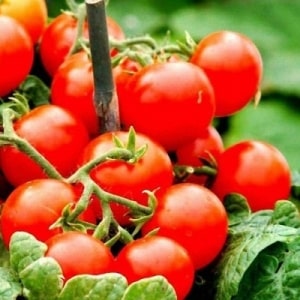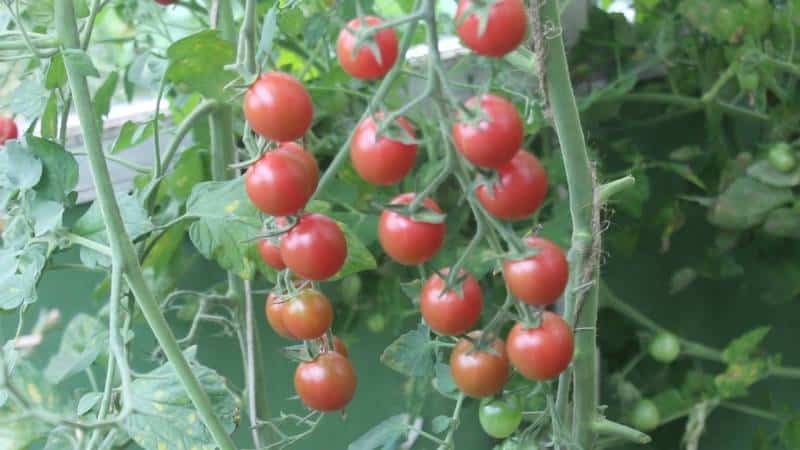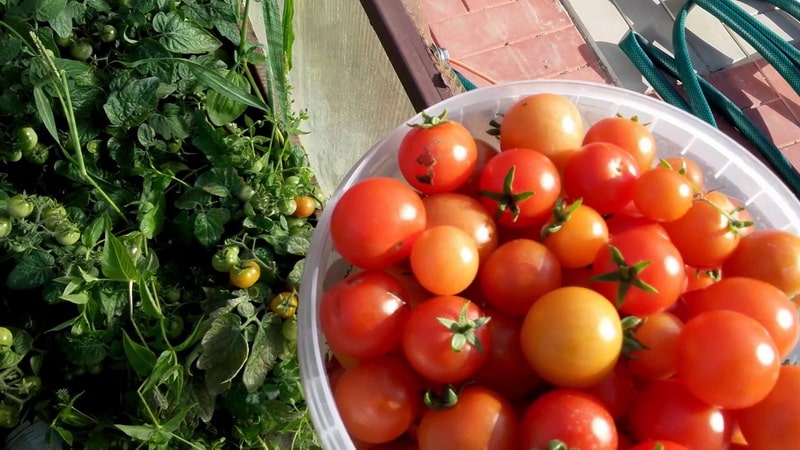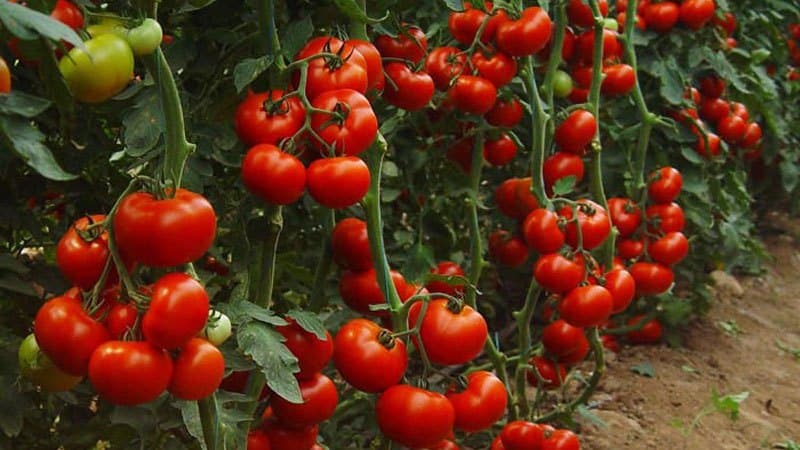A popular and beloved variety of sweet and sour cherry tomatoes: the “Japanese brush” tomato and its advantages
Cherry tomatoes enjoy constant popularity. They look aesthetically pleasing in salads and canned food. According to many gourmets, their taste is more piquant than large tomatoes. In stores, small tomatoes are more expensive than ordinary ones. Therefore, more and more gardeners are growing them in their gardens.
Among the most interesting cherry varieties is the Japanese brush tomato. This crop is characterized by high yield and excellent taste. Another advantage is its immunity to many plant diseases.
General description of the variety
The Japanese brush tomato is a small and graceful cherry tomato. The variety was bred by Japanese breeders. It appeared on the Russian market relatively recently.
Bushes of this variety are characterized by constant growth. They belong to indeterminate crops and reach a height of two meters.
Japanese brush is grown both in greenhouses and in open ground. In the northern regions, experienced gardeners note that the highest yields are achieved precisely when grown in greenhouses and greenhouses.
The variety needs pruning and pinching. Otherwise he is unpretentious.
Note! The Japanese brush tomato can also be grown on the balcony. In this case, the harvest will not be as abundant, but the fruits will remain just as tasty.
Distinctive features of the Japanese brush
Japanese brush is small red fruits weighing up to 60 g. The fruits have juicy pulp and a sweet, slightly sour taste.The fleshiness of the tomatoes is average. They contain a lot of juicy small seeds.

The fruits of the Japanese brush are used mainly for cooking hot dishes and conservation. They can also be consumed raw.
The main distinguishing feature of the Japanese brush is the variety’s resistance to a number of plant diseases. This makes it easier to care for.
High yield is another feature of the crop. With proper care, you can collect more than a hundred small fruits from one bush.
Characteristics
Despite the fact that the Japanese brush cherry tomato has only recently appeared on the markets of our country, it has already begun to rapidly gain popularity. This is due to its excellent characteristics.
Description of the Japanese brush:
| Parameter | Indicators |
| Bush type | Indeterminate. Grows up to 2 meters in height. They have light green foliage and a medium number of leaves. The stems are dense. |
| Growing method | Suitable for growing in open ground and in greenhouses. The first method is mainly grown in warm regions with long summers. |
| Productivity | High. More than 100 fruits can be collected from one bush per season. |
| Fruit | Red inside and out. They have a dense skin and juicy pulp. Small, weighing from 30 to 60 g. Medium-fleshed with a sweet and sour spicy taste. |
| Transportability | High. The fruits have a strong skin, so they do not crack during transportation. Can be stored for more than 2 weeks. |
| Ripening time | Mid-season variety. The fruits will ripen by mid-summer. In the greenhouse, fruiting continues until the end of autumn. In open ground - until the first frost. |
| Disease resistance | Tobacco mosaic, crown and root rot. |
Growing seedlings
In our country, the crop is planted in open ground or soil in a sprouted and mature form. Planting material is planted in late February - early March. When choosing the time to sow seeds, follow the lunar calendar.
Preparing the seeds
Preparing seeds is an important step in growing seedlings. If done correctly, you will grow healthy plants and get excellent germination rates.
Preparing seeds for sowing:
- Before purchasing seeds, make sure they are not past their expiration date. If using seeds from tomatoes from a previous harvest, this step can be skipped.
- Clean up the planting material. Remove all damaged, black and moldy seeds.
- The seeds are soaked overnight in a light pink solution of potassium permanganate. The floating seeds are removed; they will not germinate. You can treat the seeds by soaking them for 3 hours in a weak solution of hydrogen peroxide.
- The seeds are treated with a growth stimulant. To do this, they are soaked for another night in a special solution (Epin, Zircon or humate, diluted in a ratio of 1: 100) or in water. To do this, they are placed in gauze soaked in a special composition until germination.
A few words about container and soil
Choosing a container is another important step in preparing for growing seedlings. Different containers are used for sowing seeds.
First, all the seeds are sown in one container. Therefore, the first container should be large. Special plastic trays or wooden boxes are suitable for these purposes. You can make containers from scrap materials.
When the plants germinate, they are transplanted into individual pots. For these purposes, small peat containers or plastic cups are used.
The soil is sold in a specialized store.You can prepare the soil mixture yourself by mixing peat and turf soil with humus in equal proportions.
Both purchased and homemade soil need to be treated. To do this, it is poured with a light pink solution of potassium permanganate or calcined in the oven at a temperature of 100 degrees.
We sow planting material
Planting material is sown into the soil, deepening it to 1 cm. To do this, make grooves in the ground of appropriate depth. Seeds are poured into them at a distance of 0.5-1 cm from each other.
Boxes with seedlings are placed on the windowsill. They are first covered with film. The optimal temperature for seed germination is 25 degrees.
Airing the seeds will not allow moisture to stagnate. In warm weather, regularly open the film for 2 hours.
Advice! It is not necessary to place the seedlings on the windowsill. If you have a special lamp with ultraviolet lighting, boxes with planting material can be placed in any part of the room.
Nuances of caring for seedlings
It is important to properly care for seedlings. Only in this case will you be able to get healthy and strong plants that will give a bountiful harvest.
Rules for caring for seedlings:
- The first watering of seedlings is carried out a week after planting. It is sprayed from a spray bottle with settled water at room temperature. Subsequently, water as the soil dries.
- Make sure that the plants do not freeze. The film can be removed after all the seeds have sprouted.
- After true leaves appear on the plants, the sprouts are planted in individual pots. It is important to do this carefully so as not to damage the formed roots.
- After transplanting the seedlings, water it with a small amount of water. After 5-7 days, the plants are fed with complex fertilizers.
- Two weeks before planting, you need to start hardening the seedlings. To do this, the pots are taken into the greenhouse, outside or onto the balcony. The first time, hardening lasts an hour, then the time is increased by another hour. So gradually the time the plants stay outside increases to a whole day.
Growing tomatoes
When the soil warms up enough, the tomatoes are planted in the ground. This is usually done in early or mid-June.
Japanese bunch is grown in open ground or in greenhouses. For regions with cold climates, the second option is more suitable.

Planting seedlings in the ground
Tomatoes are planted either in mid-late May or early-mid June. It depends on the climate of the region in which you live. Japanese bunch is a variety that is not highly resistant to temperature changes. Therefore, night frosts can cause the death of fragile plants.
For one sq. m, 3-4 tomato bushes are planted. The crop planting pattern is 30/50 cm.
Ash and compost are poured into the holes in which the tomatoes will be planted. They are also watered generously with warm water.
The seedlings are buried until the first lower leaves. To form additional roots, elongated plants can be planted to a depth of 2-3 leaves.
The tomatoes are watered for the first time 10 days after transplanting the seedlings to a permanent location. During this time, the tomatoes will have time to adapt to new conditions. At the same time, feeding is also done.
Care
Japanese brush is a variety with constant growth. Therefore, it needs gartering and shaping. Form a bush into two stems, this increases the yield.
Stepping is carried out regularly. When pinching, the lower shoots and leaves are removed. It is necessary to remove all wilted and damaged greens.Such manipulations are performed no more than once a week. There is no need to water on the day of planting.
Water the tomatoes once a week. In hot weather, this can be done more often - 2-3 times a week.
Japanese brush tomato bushes require a mandatory garter. For this purpose, special supports are used, for example, wooden planks.
It is important to feed tomatoes regularly. This will increase their yield and speed up the process of fruit set.
Feeding tomatoes:
- Mineral fertilizers. They are applied 2-3 weeks after planting tomatoes in the ground. The first feeding includes superphosphate and potassium sulfate (20 and 15 g per 1 sq. m). The second and third feeding is carried out at the stage of fruit formation. To do this, for 1 sq. m, 15 g of ammonium nitrate and 20 g of potassium sulfate are used.
- You can feed plants with organic fertilizers. To do this, use a solution of manure fermented with weeds. A mixture of 1 bucket of weeds, 1 bucket of manure and 100 liters of water is prepared. When the mixture ferments, it is diluted at a rate of 1:10.
- Boric acid is used for foliar feeding.
Growing Tips
To get a good harvest, you need to know some of the intricacies of growing tomatoes. Below are the most important of them.

Tips for growing tomatoes:
- It is better to additionally tie heavy tassels with a large number of small fruits to a support. Otherwise, the stalk may break.
- Water the plants only at the roots. This will reduce the likelihood of them being affected by plant diseases.
- Mineral and organic fertilizers are introduced in the form of irrigation. It is important not to get the composition on the greens and plant stems.
- Regular loosening of the soil is necessary for the full growth of tomatoes.
Diseases and pests
The Japanese brush tomato is resistant to blossom end and root rot and tobacco mosaic. The gardener will have to fight other plant diseases.
Pests are collected from tomatoes by hand. There are chemicals that prevent their appearance, but gardeners advise not to use them to obtain a better and healthier harvest.
Careful weeding of the beds will save the plants from mole crickets. For the same purposes, in the autumn, when preparing the bed, eggshells are poured into the soil.
For late blight, Bordeaux mixture is used. You can also use special preparations, for example, Polyazophos or Ditan.
Brown spot can be combated with the help of Fundazol. When signs of powdery mildew appear, spray with Bayleton.
Differences between growing in a greenhouse and in open ground
Japanese brush can be grown both in open and protected ground. However, there are several differences in caring for tomatoes growing in a greenhouse and outdoors.
Seedlings are planted in the greenhouse 1-2 months earlier.
After transplanting seedlings into open ground, for the first two weeks they are covered with film at night. This will prevent its death during the night cold snap.
When growing tomatoes in the garden, choose places where the crop will not be exposed to the scorching sun. It is better to plant tomatoes in partial shade.
You cannot plant tomatoes in the same place for two years in a row - regularly change the location of the tomato beds.
Don't forget to ventilate the greenhouse. To do this, in hot weather, open windows and doors for several hours.
Harvesting and application
In mid-summer they begin to collect ripened fruits. This must be done regularly so that the plants are not affected by late blight.
Cherry tomatoes are usually picked in whole bunches. You need to wait until most of the fruits are ripe. In such varieties this happens evenly.
You can also pick slightly unripe fruits. They will turn red even at home.
A few ripened tomatoes in the garden can be left to obtain new seeds. To do this, select the pulp with seeds from them and soak them in water at room temperature for 2-3 days. After this, the planting material is dried and stored in fabric bags or coffee filters.
Advantages and disadvantages of the “Japanese brush”
Japanese brush has many advantages:
- high productivity;
- long fruiting;
- great taste;
- good transportability;
- resistance to tobacco mosaic, blossom-end and root rot;
- possibility of growing in open and protected ground;
- versatility of fruit use.
This variety has few disadvantages. These include the need for staking and pinching, instability to temperature changes and immunity to a small number of plant diseases.

Farmer reviews
Many farmers like the Japanese brush tomato. Reviews about this variety are mostly positive.
Reviews of the Japanese brush tomato:
Vishnevskaya Victoria, Odessa «I have been growing Japanese Brush cherry for two years now in a greenhouse. I like the abundant harvest and sweet and sour taste of tomatoes. Can be used for salads and canning. Uncapricious. There are no complaints."
Orlov Grigory, Tula " I have a Japanese brush tomato growing in open ground. Very beautiful small fruits. It is imperative to treat for late blight and other diseases. Tomatoes have a sweet and sour taste; it seems to me that they are more suitable for canning.”
Conclusion
The Japanese Brush tomato is a variety that produces a bountiful harvest of small cherry tomatoes. It is suitable for preservation and fresh consumption.
Cherry tomato is suitable for growing in greenhouses and open ground. He is immune to a number of diseases. Needs gartering and pinching. Otherwise it is considered an unpretentious variety.